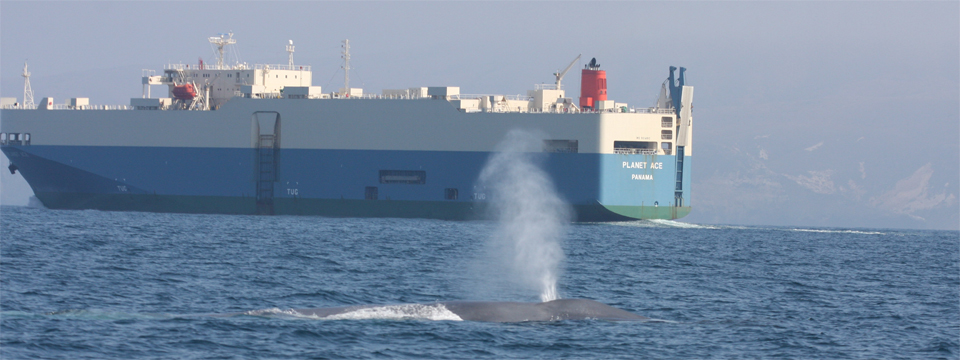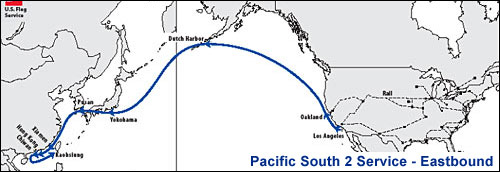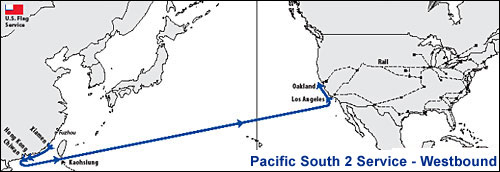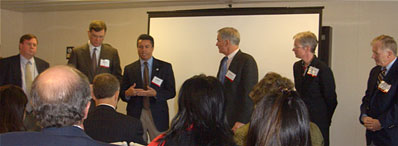
Webpage Links: Previous Vessel Speed Reduction (VSR) Programs | Local Studies & Actions | Initiatives | 2007 Retrofit Project
Background – Marine Shipping Retrofit Project
The Maritime Working Group, formed by the California Air Resources Board (CARB) to discuss maritime air quality issues, developed a marine shipping retrofit program. Participants in the working group includes representatives from the District and other California air districts, the United States Environmental Protection Agency (EPA), the U.S. Department of Transportation’s Maritime Administration (MARAD), environmental organizations, port authorities, ship owner-operators, large engine manufacturers, and emission-control technology companies.
The District and several other members of the group began with a goal of developing a fund with an initial target of $1 million to implement and test retrofit strategies and technologies on vessels that operate in California waters. The immediate objective was to reduce emissions from two or three ships transiting the area, using cost-effective emission reduction technologies that can be adapted for use by other ships. In October of 2003, The District’s Board approved allocating $100,000 towards the retrofit program (download the Board letter here). The long-term goal was to document the emission reduction technologies and other information gained from the implementation phase in order to promote additional programs, projects, and potential incentives to reduce marine shipping emissions.
The five principal objectives of the program were as follows:
- Develop an understanding of ship activities and emissions.
- Evaluate potential control technologies.
- Develop partnerships and funding mechanisms.
- Implement retrofit technologies.
- Document results.
APL SINGAPORE Retrofit
The group evaluated several control technologies, and worked with ship owners/ operators to assess the possibility of retrofitting a ship(s) with emission control technologies. The group worked with APL to demonstrate the feasibility of retrofitting the ocean-going vessel the APL SINGAPORE. Below is information on: vessel specifics, the emission control technologies, funding, and the 12/4/06 APL media event, as well as links to the project partner’s websites.
Project Specifics
Vessel Information | |
| Vessel Name | APL Singapore |
| Ship type | Post-Panamax Container ship |
| Flag | United States |
| Built | 1995 |
| Gross Tonnage | 64,502 |
| TEU Capacity | 5,108 TEU |
| Length/Breadth/Depth | 863′ / 131′ / 66′ |
Engine Information | |
| Engine | MAN B&W |
| Model | 11K90MC-C |
| Type | 2-Stroke Engine |
| Power | 66,398 hp |
The APL SINGAPORE at that time operated on APL’s PS2 (Asia to North America) route. The eastbound and westbound routes are shown below.


Emission Control Technologies
Two emission control technologies were installed on the main engine of the APL SINGAPORE for use on California calls: a fuel/ water emulsion system and slide-valves. Water in fuel emulsion is the process of introducing water into the fuel prior to injection into the combustion cylinder. Introducing water into the combustion cylinder reduces the maximum peak combustion temperature and the formation of nitrogen oxides (NOx). The in-cylinder evaporation of the water also improves the atomization of the fuel causing it to burn more completely. This system was installed and connected to the ship’s main engine and was expected to yield a 1% reduction in NOx for every 1% concentration of water in the emulsion. Different concentrations of water were tested to determine the emulsion level that best reduces emissions. NOx reductions up to 25% are expected from this control technology.
Particulate Matter (PM) is a product of incomplete combustion, and unburned fuel; therefore the optimization of the fuel injection system was expected to result in the reduction of fuel consumption and a reduction of PM emissions. Slide valves were installed on the vessel’s main engine and differ from conventional valves in their spray patterns that are designed to reduce the dripping of fuel from the injector into the combustion zone post injection. The slide valves were expected to reduce PM emissions by about 25%.
Additional Funding
The funding for this project came from a number of different agencies. In 2005, the District supported an application by the Bay Area Air Quality Management District (BAAQMD) for funding from the CARB Multi-district Carl Moyer funding program. The application was successful in securing grant funds that, when combined with the EPA contribution covered the purchase and installation of the control technology, allowing the other funds to be used to cover the emissions testing costs. In an effort to expedite the testing coordination process, District staff volunteered to accept funding from project partners and contract with the emissions testing contractors selected for the project. The Ports of Los Angeles and Long Beach in addition to the Ventura County, San Luis Obispo County and Santa Barbara County air districts contributed funds towards the testing portion of the project. The installation of the emulsification equipment was completed in early 2007 and the emissions testing began in March/April 2007.
APL Media Event aboard the APL SINGAPORE: December 4, 2006

Speaker panel for the APL media event (from left to right): Eric Hutchingame – Sea to Sky Pollution Solutions; John Bowe – President of APL (Americas); Wayne Nastri – US EPA Region 9 Regional Administrator; Mike Zampa – APL Director of Corporate Communications (Americas); Jean Roggenkamp – BAAQMD Deputy APCO; and Dr. Wayne Miller – UC Riverside, Emissions and Fuels Manager.
District visit to the APL Singapore October 15, 2007
In October 2007, Tom Murphy, Ron Tan, and Anthony Fournier from the District visited the APL SINGAPORE at the Port of Los Angeles. The vessel had just returned from its voyage across the Pacific. On this voyage, an emissions testing crew studied the emissions characteristics of the vessel’s main engine and auxiliary engine under different conditions (including the use of emulsified fuels in the main engine).
During the visit to the ship District staff witnessed the installation of some of the slide valves that were purchased as part of the demonstration project to reduce emissions. The emission testing was to continue as the vessel departed Los Angeles for Oakland, at which point the emissions testing crew would depart the vessel. See below for pictures from the visit.
For more information…
View December 4, 2006 presentation by Eric Hutchingame of Sea to Sky Pollution Solutions here.
Selected articles on the project (not a complete listing)
- Los Angeles Times, December 5, 2006, “Shipper to Test System to Cut Emissions” on the paper’s website here.
- Wall Street Journal, December 2006, “Shipper APL Adapts Fuel Use For California Ports” online here.
- Sustainable Shipping website, December 5, 2006, “APL turns to technology to reduce emissions,” online, here.
- MarineLink, December 5, 2006, “APL Aims to Cut Emissions,” online here.
Project Participants
California air districts
- Bay Area AQMD – www.baaqmd.gov
- Ventura County APCD – www.vcapcd.org
- San Luis Obispo County APCD – www.slocleanair.org
- Santa Barbara County APCD – www.ourair.org
Ports
- Port of Los Angeles – www.portoflosangeles.org
- Port of Long Beach – www.polb.com
State and Federal government
- California Air Resources Board – www.arb.ca.gov
- U.S. Environmental Protection Agency – www.epa.gov
- Maritime Administration of the U.S. Department of Transportation – www.marad.dot.gov
Shipping company: APL – www.apl.com
Emissions testing contractor: MAN Diesel – www.marine.man.eu
University of California at Riverside, Center for Environmental Research & Technology (C-CERT) – www.cert.ucr.edu

